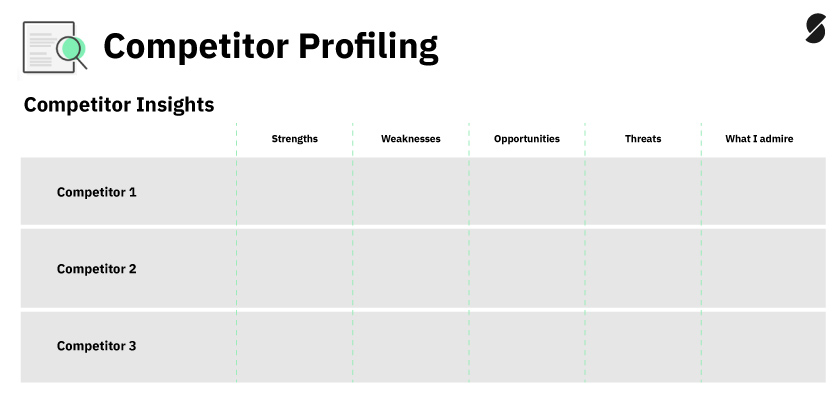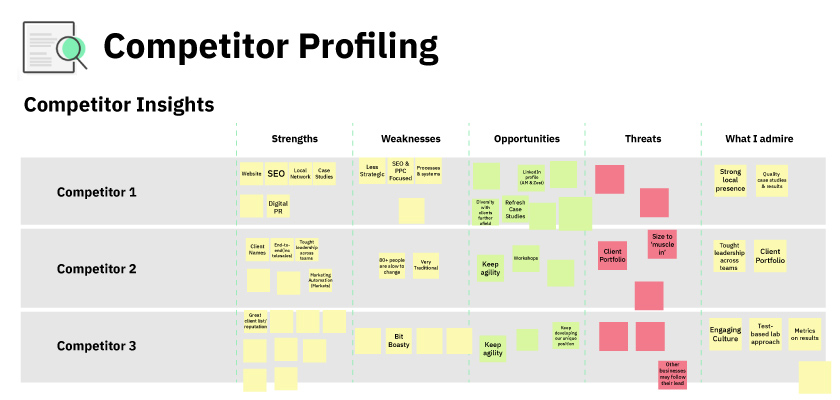
You’ve probably heard the phrase “know your enemy.” Well, in business, it is just as important to know your competitors. Knowing what they are up to can give you a competitive advantage when deciding which route to take with your own business.
This article will show you why profiling your competitors is crucial, how to use SWOT analysis for competitor insights, and how doing so can give you an edge over other companies in the industry.
Why Profiling Your Competitors Is Important
A big part of success in business is being a step ahead of your competition. That’s why, regardless of how well you know a company or industry, it’s crucial to always be aware of what the competition is up to.
The first thing to do is to outline what you know about your competitors. What are their strengths? What are their weaknesses? What are their threats? Are they facing any impending changes that could have a significant impact on them? Those are just some of the questions that will help you profile your competitors.
Exercise: Growth Mapping Using Customer Profiling


In the above graphic, you’ll see an adaptation of traditional SWOT analysis. As part of our Growth Mapper Framework we use this to assess up to 3 local or online competitors and their strengths/weaknesses (including opportunities for your business). This type of analysis helps you see what you need to work on the most with your own company to stay competitive in the marketplace.
To understand the strengths and weaknesses of competitors, we use a table. In this column, we write what a competitor is good at; in that one, your rivals are strong where you aren’t. We note opportunities (and threats) for businesses with the last two columns: things to admire about other companies or strategies they have successfully implemented that could be applied elsewhere.
When you run through this exercise, it’s important to remain objective. Avoid a “blinkered” perspective because there are lots of valuable insights that can be missed if you’re too close-minded about your competition’s quality and how they’ve been able to create better experiences for their customers than yours so far.
Competition is healthy. Your competitors are there for a reason, and it’s important to be mindful of them because they push you towards excellence as well!
Let’s first look at our competitors’ strengths…


Strengths
The strengths section of a SWOT analysis is all about identifying the positive attributes that a company has. It’s important, to be honest with yourself when completing this part, as you’ll need to have confidence in what you’re doing if it’s going to pay off for your organization!
You might want to compare what you’ve done against other companies that are also strong in the same area and see how they differ from yours. If your competitors are really successful at something, there must be some good reason why… so think about why they succeeded where others haven’t.
Is their success due to luck? To having better resources or staff? Or were they just more innovative than everyone else? This will help you understand how close or far away your company is.
To complete the first section, you’ll need to decide who your competitors are. You can work on one, two, or three!
Weaknesses
Here, you’ll identify your competitors’ weaknesses. This is a lot harder than identifying their strengths, and you might need to really think about the power they possess in order to pinpoint what they’re weak at.
Is there something they do which you could easily (or too easily?) replicate and do better? If they’ve been in business for years and they’ve never had a positive review, they probably have some kind of weakness.
Researching this part of the SWOT analysis can help you understand what areas your company should focus on when you evaluate your competitors. Think about how it will help you out when reviewing your current strategy!
Opportunities
This is the most difficult section to complete.
However, it’s also one of the most important parts of a SWOT analysis because if you don’t understand what your competitors are doing right now, you won’t know how to improve upon their successes or capitalize on their mistakes.
Your company may be successful in some areas and not others – and that’s okay! You can use this information to figure out where you need improvement, but for now, just focus on looking at what your competition does well – the opportunities they have provided. If your competitors are great at marketing, but their products are sub-par, you know that if you can provide better quality than them then they’ll switch to using your services.
This part of the SWOT analysis will help give you new ideas for how to improve on what’s already popular with customers – and it may even inspire some innovation!
To complete this section, think about all the things your competition does really well or where there is potential for something positive happening in the future. You might be able to do similar things yourself…so keep an open mind!
Threats
This is the final section of a SWOT analysis. It’s all about identifying threats. A threat could be anything from another company offering a fresh take on your idea, to your customers hiring you to do something for them but then taking their business elsewhere because it wasn’t done well enough.
Notice the difference between threats and opportunities, though?
Threats are about things that can actually happen–opportunities are about what will happen if you do something.
The key thing to remember when completing this section is that not everything listed will actually happen–only identify risks that you know could really come into play when it comes to your business and its success in order to get an accurate picture of what’s going on in the world around you.
Things I Admire
In the final column, we ask you to be honest and positive about your competitors and look at what they’re doing well.
This section is all about consolidating your thoughts to make sure you understand where your competitors might have an edge, what you like about them, or what you think is admirable about their products. This part of the SWOT analysis should help you think about how to make your business better, and achieve a wider reach–which is what everyone wants!
Now that you’ve learned about how to benchmark competitors, it’s time to go out and do something with this information. The end goal here is simple; we want you to come away from reading this article with several ideas for how your business can better match (or even beat) your competitor(s).
Key Takeaway
A competitor SWOT analysis can help you to get a fresh perspective by looking at your business from the outside in. It’s an opportunity for innovation and improvement that will give you greater insight into how your competitors operate, which could allow for new strategies or opportunities within your own organization.
Download the Profiling Workbook here to get started.


